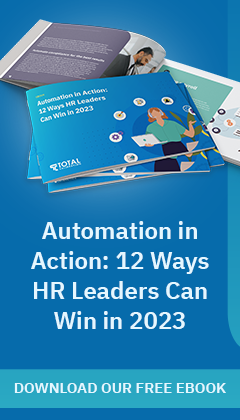The success of your organisation heavily depends on effective recruitment and onboarding. Candidates who have a positive experience during the hiring process are more likely to recommend your company, even if they don't secure the job. A seamless onboarding procedure can make the difference between a new employee swiftly adapting to their role or becoming confused, frustrated, and potentially disengaged from the outset.
With 20% of turnover occurring in the first 45 days of employment, it’s critical to get recruitment and onboarding right. These areas have conventionally demanded significant time and effort from HR teams, requiring extensive coordination and documentation handling for candidates and new employees. Moreover, the process of sifting through numerous CVs to identify the appropriate experience and skills can be incredibly time-consuming.
HR automation is crucial in streamlining these processes. By automating recruitment and onboarding, your HR team can save time, reduce errors, improve compliance, and provide a better experience for candidates and new hires.
Here are five ways automation creates a better experience for your HR team, candidates and hires.
1. Assessing applicants for job ads
Traditional processes for sorting through applicants can be time-consuming, labour-intensive, error-prone and subject to bias. HR automation streamlines applicant assessments using technology to identify the best candidates based on predefined criteria.
HR automation tools can screen and shortlist candidates by (courteously) declining those who do not meet the minimum job requirements. By evaluating candidate responses to job opening questions and scanning CVs for keywords or phrases that align with specific job requirements, HR automation software can effectively filter out applicants who lack the necessary qualifications.
HR automation can also administer candidate assessments. These tests can measure candidates' skills and knowledge relevant to job requirements, providing a more comprehensive understanding of their qualifications.
Finally, HR automation can track the progress of each applicant and provide a centralised platform for HR professionals to manage the recruitment process. This approach standardises the process, assesses all candidates against the same criteria and that recruitment practices are consistent across the organisation.
2. Automating onboarding processes
Traditionally, onboarding has been time-consuming, requiring HR professionals to manually input data, collect documents, and prepare training materials. However, many of these tasks can be automated, making the onboarding process more efficient and effective.
HR automation can reach out to hires and collect their information, reducing the need for HR teams to complete this manually. Automation collects personal and contact information, emergency contacts, and other necessary data. It also streamlines digital collection and processes banking, tax and superannuation details.
Additionally, HR automation can automatically assign training and onboarding materials to new hires, including mandatory compliance training, job-specific training and policy acceptance. This automation ensures new hires can access the information they need to succeed in their roles.
3. Processing documentation
Documentation is crucial to the onboarding process as it ensures that new hires have the necessary paperwork completed and on file. This documentation can include employment contracts, tax and banking forms, identity verification, licenses and permits etc. Without proper documentation and record keeping, there can be legal and compliance issues for both the organisation and the new hire.
HR automation can simplify the documentation processes in several ways. It can collect necessary documents from new hires, reducing manual data entry and the risk of errors. This automation can include collecting signatures, uploading documents, and storing them securely. HR automation can also verify and approve documents, ensuring that all necessary documents are present and correct and approving the documentation for the next stage of the onboarding process.
Finally, automation improves document management by creating a central repository for all onboarding documents. Automation can record when certain people complete and approve each document, ensuring that the team finishes the onboarding process efficiently.
4. Reports on the new hire’s progress
Tracking and monitoring new hires' progress is crucial to ensure that the onboarding process is successful and that new hires integrate into the company culture and work environment. HR professionals need to have visibility into the progress of new hires, including completion of required training, adherence to company policies and procedures, and job-specific tasks. This tracking and monitoring can be time-consuming and challenging, especially in larger organisations, where many new hires may exist simultaneously.
HR automation can help streamline tracking and monitoring new hires' progress by generating reports summarising their onboarding progress. These reports can provide information such as completed tasks, training progress, compliance status, and any outstanding items that need attention. This information can be used by HR professionals and managers to identify areas where new hires need additional support and to ensure hires complete their assigned tasks on time.
HR automation can also provide real-time updates on new hires' progress, allowing HR professionals and managers to respond quickly to any issues during onboarding. This real-time tracking means that teams can identify potential roadblocks early on and address them before they become bigger issues.
5. Offboarding
Of course, we cannot address recruitment and onboarding without accounting for offboarding. Offboarding involves numerous processes, such as collecting company assets, terminating access to company systems, processing payouts and conducting exit interviews – to name a few.
HR automation streamlines offboarding by recording company property returned by departing employees, including laptops, mobile phones, and access cards. Automation can also revoke access to company systems and facilities, ensuring that departing employees can no longer access sensitive information.
Moreover, HR automation can complete offboarding tasks on time and with consistency. By automating the process, organisations can ensure that all departing employees go through the same process, reducing the risk of legal or compliance issues.
Conclusion
HR automation plays a critical role in recruitment and onboarding processes, simplifying many of the administrative tasks associated with these processes. From assessing applicants to offboarding, HR automation can save time, reduce the burden on HR professionals, and ensure that all necessary tasks are completed accurately and on time.
HR automation can also provide valuable insights into the effectiveness of recruitment and onboarding processes, enabling organisations to continuously improve these processes and provide a better experience for new hires.
Total Calibration can set up HR automation for recruitment and onboarding
Our HR software automates every aspect of the employee lifecycle — without sacrificing quality. We can help you automate recruitment, onboarding, payroll, time and attendance, expense claims, performance reviews, learning management, competency management, offboarding, succession planning and much more.
Please visit our HR automation page for more on our capabilities.


